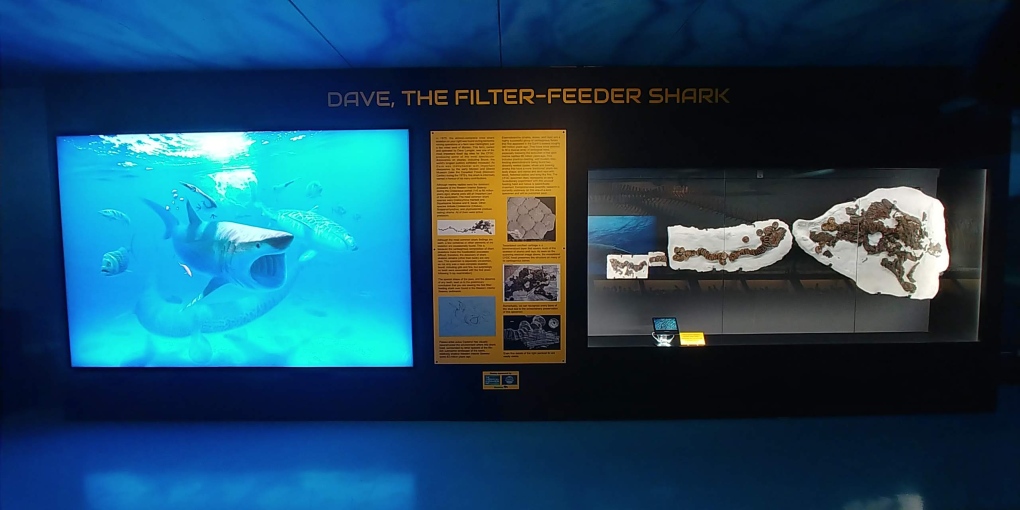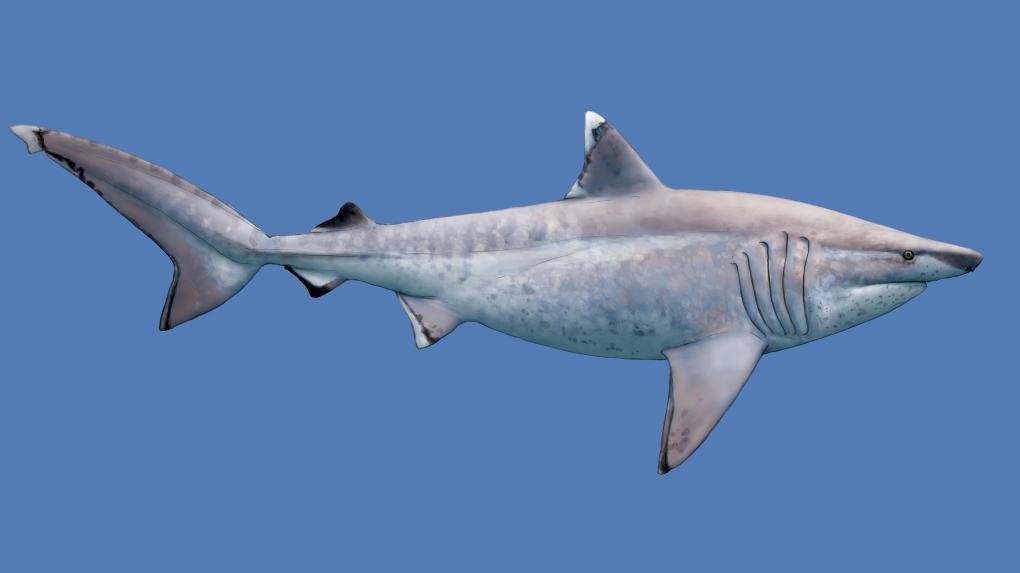'Probably going to be a new species': Ancient shark fossil found in Manitoba museum's storage after nearly 50 years
A potentially new species of ancient shark may have been discovered at the Canadian Fossil Discovery Centre in Morden, Man. However the fossil has been in the museum’s possession for nearly 50 years.
The fossil was originally discovered in 1975 on a farm west of Morden.
Adolfo Cuetara, the executive director of the Canadian Fossil Discovery Centre, said bentonite mining was happening in the area and that’s when the fossil was found.
He said the fossil was brought back into the museum and put into storage, noting many fossils were collected at that time, so it was forgotten in the collection. That is, until a few years ago.
“Finally, we discovered it was actually a shark,” said Cuetara.
There is no official name yet for the shark, but the centre has currently named it “Dave” after the owner of the farm where it was discovered.
Cuetara said there are a few things that make Dave significant. The first being the team at the centre believes it is a new species of ancient shark – confirmation they are currently waiting on.
“The shape of the jaws and the skull and the kind of structures that it has, because the preservation is really amazing, is telling us that it is probably going to be a new species. The problem is now we need scientific papers, scientific research and this paper is underway.”
 The exhibit for the newly discovered shark fossil at the Canadian Fossil Discovery Centre in Morden. (Source: Adolfo Cuetara/Canadian Fossil Discovery Centre)
The exhibit for the newly discovered shark fossil at the Canadian Fossil Discovery Centre in Morden. (Source: Adolfo Cuetara/Canadian Fossil Discovery Centre)
The second is how well preserved it is, something he said is hard to find.
“The shark skeleton is made of cartilage, not bone. So it is very difficult to preserve this material, it is very soft, so it normally just disappears. The part we normally find from the shark is the teeth, because they are the only hard part of the skeleton. But, in this case, we have an almost complete shark skeleton with no teeth. The explanation is that it was a basking shark, a filter-feeder shark.”
A similar comparison to Dave in the present day would be a whale shark, Cuetara said.
He said it’s believed Dave is the largest fossilized shark in the world, measuring around 15 feet.
 The rendering of a shark fossil at the Canadian Fossil Discovery Centre. (Source: Adolfo Cuetara/Canadian Fossil Discovery Centre)
The rendering of a shark fossil at the Canadian Fossil Discovery Centre. (Source: Adolfo Cuetara/Canadian Fossil Discovery Centre)
In the Cretaceous period, which was 85 million years ago, the prairies were underwater and the sea was connected from the Hudson Bay all the way to the Gulf of Mexico. Cuetara said it was known as the Interior Seaway.
“This is the only basking or filter-feeder shark known in this Interior Seaway at the time…it is giving wider information about the life at that time in the Interior Seaway.”
Dave is currently on display at the Canadian Fossil Discovery Centre and the museum has included as much information as they know with the exhibit.
CTVNews.ca Top Stories

'Mayday!': New details emerge after Boeing plane makes emergency landing at Mirabel airport
New details suggest that there were communication issues between the pilots of a charter flight and the control tower at Montreal's Mirabel airport when a Boeing 737 made an emergency landing on Wednesday.
Trudeau appears unwilling to expand proposed rebate, despite pressure to include seniors
Prime Minister Justin Trudeau does not appear willing to budge on his plan to send a $250 rebate to 'hardworking Canadians,' despite pressure from the opposition to give the money to seniors and people who are not able to work.
Hit man offered $100,000 to kill Montreal crime reporter covering his trial
Montreal news outlet La Presse says a hit man offered $100,000 to have one of its crime reporters assassinated.
Cucumbers sold in Ontario, other provinces recalled over possible salmonella contamination
A U.S. company is recalling cucumbers sold in Ontario and other Canadian provinces due to possible salmonella contamination.
Trudeau says no question incoming U.S. president Trump is serious on tariff threat
Prime Minister Justin Trudeau says incoming U.S. president Donald Trump's threats on tariffs should be taken seriously.
In a shock offensive, insurgents breach Syria's largest city for the first time since 2016
Insurgents breached Syria's largest city Friday and clashed with government forces for the first time since 2016, according to a war monitor and fighters, in a surprise attack that sent residents fleeing and added fresh uncertainty to a region reeling from multiple wars.
Canada Bread owner sues Maple Leaf over alleged bread price-fixing
Canada Bread owner Grupo Bimbo is suing Maple Leaf Foods for more than $2 billion, saying it lied about the company's involvement in an alleged bread price-fixing conspiracy.
Here's how thick ice needs to be to park a truck on it, according to Sask. Water Security Agency
The Saskatchewan Water Security Agency (WSA) says ice should be at least one foot (30 centimetres) thick before it's safe to drive a car or light truck on a frozen body of water.
Democratic lawmakers from Connecticut report Thanksgiving bomb threats against their homes
At least six Democratic members of Congress from Connecticut were targeted by bomb threats on their homes Thursday, the lawmakers or their offices said.

































